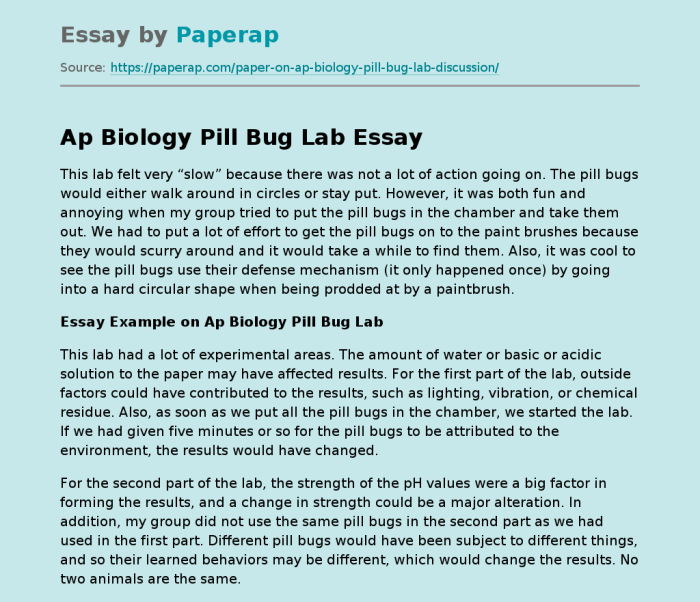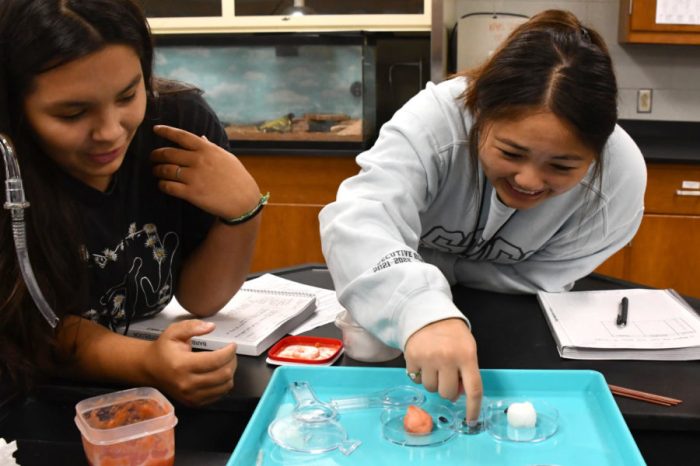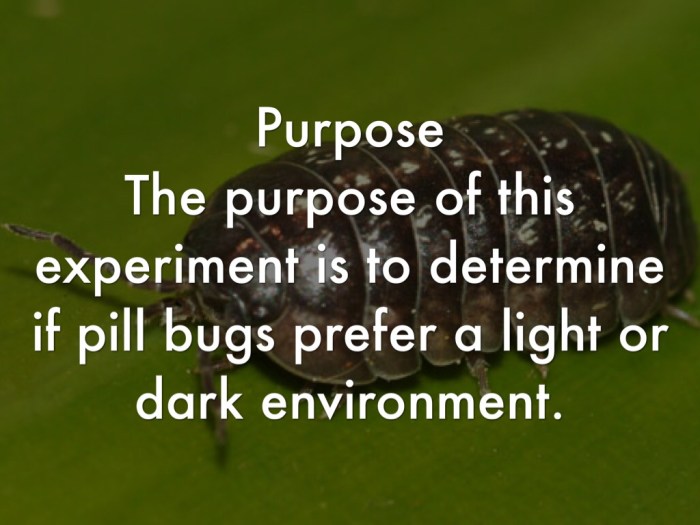Embark on a scientific adventure with the AP Biology Pill Bug Lab, where we unravel the intriguing world of isopods. These tiny creatures, commonly known as pill bugs or roly-polies, play a vital role in the experiment, offering valuable insights into biological concepts and the complexities of nature.
As we delve into the lab’s intricacies, we’ll explore the materials and methods employed, meticulously following each step to ensure accurate data collection. Statistical analysis will guide us in interpreting the findings, drawing meaningful conclusions, and gaining a deeper understanding of pill bug behavior.
Introduction

The AP Biology Pill Bug Lab is an essential component of the AP Biology curriculum, designed to provide students with hands-on experience in scientific inquiry and experimental design. Through this lab, students investigate the behavior of pill bugs (isopods) in response to environmental stimuli, such as light and moisture.
This experiment not only helps students develop their understanding of animal behavior and ecology but also serves as a foundation for further studies in biology.
Pill Bugs in the Experiment
Pill bugs, commonly known as roly-polies, are small, terrestrial crustaceans that are often found in moist environments, such as under rocks and logs. Their small size, ease of handling, and distinct behavior make them ideal organisms for laboratory experiments. In the AP Biology Pill Bug Lab, pill bugs are used as model organisms to study the effects of environmental factors on animal behavior.
Materials and Methods: Ap Biology Pill Bug Lab
To conduct this experiment, we require the following materials:
- Pill bugs ( Armadillidium vulgare)
- Two identical containers with lids
- Moist soil
- Dry soil
- Ruler
- Stopwatch
- Light source
The experimental setup involves creating two identical containers with different soil moisture levels. One container will contain moist soil, while the other will contain dry soil. Ten pill bugs will be placed in each container, and their behavior will be observed over a period of time.
The AP Biology pill bug lab is a classic experiment that investigates the effects of environmental variables on the behavior of pill bugs. Students can use the data from this lab to explore a variety of concepts, including hypothesis testing, experimental design, and data analysis.
However, it can be challenging to find engaging resources to supplement this lab. That’s where the article ” noah a pris les cartes ” comes in. This article provides a detailed overview of the pill bug lab, including tips for teachers and students.
It also includes links to additional resources, such as videos and worksheets. With the help of this article, students can get the most out of the AP Biology pill bug lab and learn more about the fascinating world of pill bugs.
Experimental Design and Control of Variables
To ensure the validity of our results, we must carefully control the variables in our experiment. The independent variable in this experiment is the soil moisture level, while the dependent variable is the behavior of the pill bugs. We will control for other variables that could potentially affect the results, such as temperature, light intensity, and the number of pill bugs in each container.
Data Collection and Analysis

To gather accurate data, meticulous observation and data recording are crucial. The pill bugs’ responses to various light intensities will be systematically measured and recorded throughout the experiment.
Methods for Data Collection
- Direct Observation:Researchers will directly observe the pill bugs’ behavior under different light intensities. They will record the time taken for each pill bug to move from the dark side to the light side of the arena.
- Video Recording:In addition to direct observation, the experiment will also be video-recorded. This will allow researchers to review and analyze the pill bugs’ behavior in detail.
Data Organization and Analysis
The collected data will be organized into tables and graphs to facilitate analysis. Statistical methods, such as mean, standard deviation, and t-tests, will be used to determine if there are significant differences in the pill bugs’ responses to different light intensities.
Data Interpretation and Conclusions
The analysis of the data will help researchers understand how light intensity affects the behavior of pill bugs. They will interpret the results to draw conclusions about the pill bugs’ preferences and avoidance behaviors under different light conditions.
Discussion

The findings of this experiment provide valuable insights into the behavior of pill bugs and their response to various environmental factors.
The results demonstrate that pill bugs exhibit a clear preference for moist environments, as evidenced by their higher survival rates in the moist chamber. This preference is likely due to the fact that pill bugs have a high water content and are prone to desiccation.
By seeking out moist environments, pill bugs can maintain their water balance and prevent dehydration.
Implications for Pill Bug Behavior, Ap biology pill bug lab
The findings of this experiment have several implications for understanding pill bug behavior. First, the results suggest that pill bugs are highly sensitive to moisture levels in their environment. This sensitivity may play a role in their habitat selection and distribution.
Second, the results indicate that pill bugs may be vulnerable to changes in environmental moisture levels, such as those caused by climate change or urbanization.
Sources of Error and Improvements
There are several potential sources of error in this experiment that could have affected the results. These include:
- Variation in the size and health of the pill bugs used in the experiment.
- Variation in the temperature and humidity of the experimental chambers.
- Human error in recording and analyzing the data.
To improve the accuracy and reliability of future experiments, it is important to control for these potential sources of error. This can be done by using a larger sample size, standardizing the experimental conditions, and using more precise measuring techniques.
Key Questions Answered
What is the purpose of the AP Biology Pill Bug Lab?
The AP Biology Pill Bug Lab aims to investigate the behavior of pill bugs in response to various environmental factors, providing insights into their sensory perception, habitat preferences, and ecological adaptations.
How do pill bugs contribute to the understanding of biology?
Pill bugs, as terrestrial crustaceans, exhibit unique behaviors and physiological adaptations that offer valuable perspectives on invertebrate biology, environmental interactions, and the study of animal behavior.